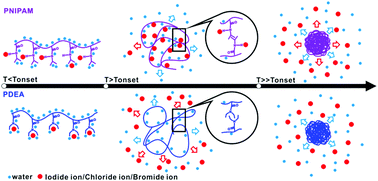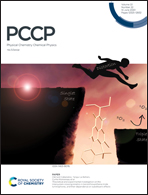Dynamic mechanism of halide salts on the phase transition of protein models, poly(N-isopropylacrylamide) and poly(N,N-diethylacrylamide)†
Abstract
The effects of salts on protein systems are not yet fully understood. We investigated the ionic dynamics of three halide salts (NaI, NaBr, and NaCl) with two protein models, namely poly(N-isopropylacrylamide) (PNIPAM) and poly(N,N-diethylacrylamide) (PDEA), using multinuclear NMR, dispersion corrected density functional theory (DFT-D) calculations and dynamic light scattering (DLS) methods. The variation in ionic line-widths and chemical shifts induced by the polymers clearly illustrates that anions rather than cations interact directly with the polymers. From the variable temperature measurements of the NMR transverse relaxation rates of anions, which characterize the polymer–anion interaction intensities, the evolution behaviors of Cl−/Br−/I− during phase transitions are similar in each polymer system but differ between the two polymer systems. The NMR transverse relaxation rates of anions change synchronously with the phase transition of PNIPAM upon heating, but they drop rapidly and vanish about 3–4.5 °C before the phase transition of PDEA. By combining the DFT-D and DLS data, the relaxation results imply that anions escape from the interacting sites with PDEA prior to full polymer dehydration or collapse, which can be attributed to the lack of anion–NH interactions. The different dynamic evolutions of the anions in the PNIPAM and PDEA systems give us an important clue for understanding the micro-mechanism of protein folding in a complex salt aqueous solvent.



 Please wait while we load your content...
Please wait while we load your content...